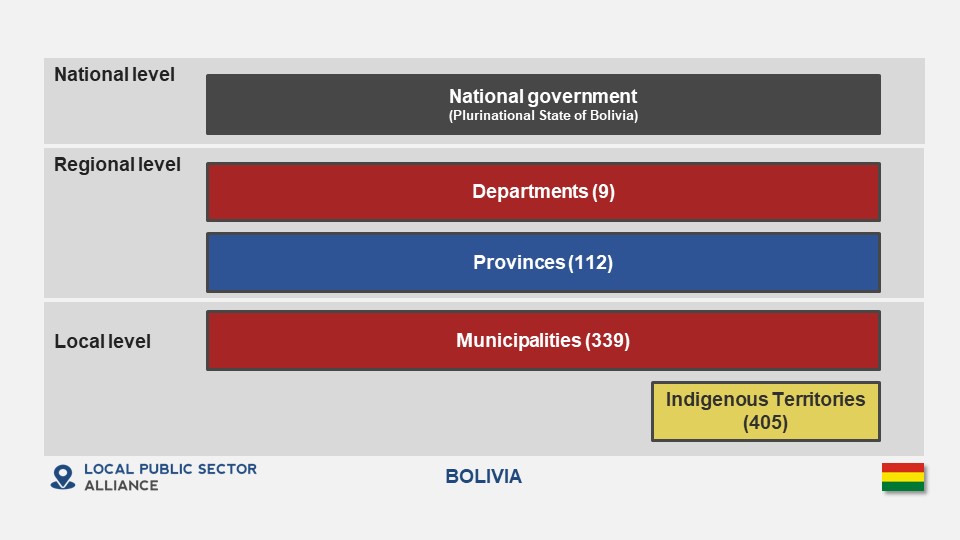
Bolivia is a unitary state, though it became highly decentralized for the standards of the region since the approval of the 2009 Constitution under President Evo Morales. For instance, Bolivian municipalities are involved in the provision of secondary and tertiary health. (By comparison, only Brazilian municipalities provide that level of healthcare in South America). Subnational spending represents around 7% of GDP. Bolivia’s subnational institutions receive most of their income from transfers from the central government through shared taxes (fiscal co-participation), followed by direct taxes on hydrocarbons, and their own subnational taxes.
Subnational governance structure
The 2009 Constitution outlines Bolivia’s intergovernmental structure. Bolivia is currently divided in 9 departments and 339 municipalities. While the Constitution and legal framework also provide for a regional and/or provincial level, in practice, the country’s 112 provinces are administrative divisions of their respective departments without their own political structures. Bolivia also has indigenous territorial councils that currently encompass 15% of the national territory. These entities are based upon traditional law and are mostly in charge of assigning land rights among indigenous communities, with other government functions being performed in these jurisdictions by other levels of subnational governments (or by the national government itself).
Nature of subnational governance institutions
The Constitution of the Plurinational State of Bolivia (2009)–along with the Framework Law of Autonomies and Decentralization (2010)–provides the foundation for subnational governance institutions at the departmental, regional and/or provincial, and municipal level, as well as for indigenous territories. In practice, departments and municipalities are devolved subnational governments institutions with their own elected leadership and extensive autonomy and authority. Provinces lack their own political leadership and are de facto non-devolved administrative subdivisions of their respective departments. Indigenous territories differ in their institutional nature or status, but are generally hybrid local governance institutions, with their own political leadership, but with mixed administrative and fiscal autonomy and authority.
Functional assignments
Subnational governance in Bolivia is complicated, with many functions being concurrent among levels of government. For instance, while municipalities are in theory charged with providing health service, while in practice, departments or the national government provide administrative or financial support. Some functions overlap, such as infrastructure provision, or land rights management in indigenous territories. The functional framework aims at establishing subsidiarity, with each level being in charge of the functions where the benefits of public services fall within the same territory. Concurrence and support among levels of government is common in functions like health and education, for which the national government establishes a national framework and then reaches agreements with departments and municipalities about the details of public service delivery. Responsibility for public security is shared by departments and the national level.
LoGICA Assessments
LoGICA Intergovernmental Profile: Bolivia 2023 (Excel)
Additional resources
Country sheet: Bolivia. Panorama de las relaciones fiscales entre niveles de gobierno de países de América Latina y el Caribe. 2022.
Local government country profile: Bolivia (UN Women)
Bolivia Country Profile (World Observatory on Subnational Governance and Investment, OECD/UCLG)
Bolivia: Urban and Cities Platform (CEPAL)
Back to Local Public Sector Alliance Intergovernmental Profiles – Country Page
Last updated: April 6, 2024


